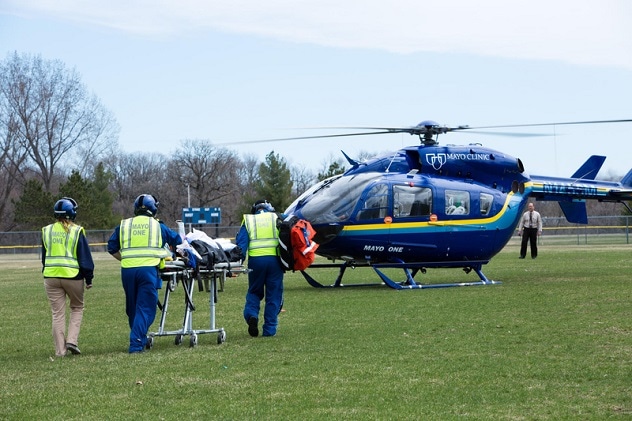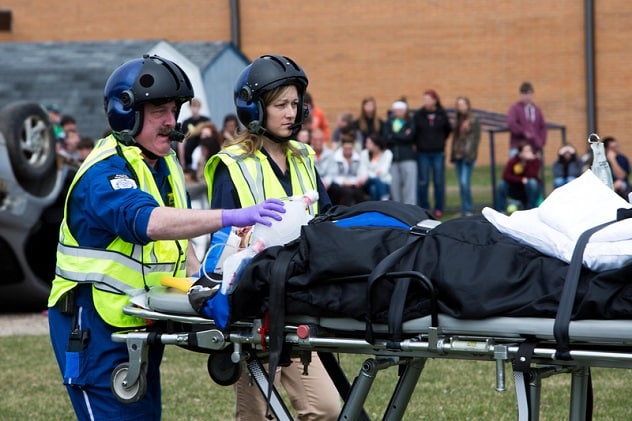March 10, 2023
Moses K. Mhayamaguru, M.D., associate medical director of education for Mayo Clinic Ambulance Service, jokingly says it has been a little over two years since "he married the EMS team at Mayo Clinic." Dr. Mhayamaguru also is an EMS fellowship faculty member. He completed emergency medicine residency and subsequently completed his fellowship in EMS at the University of Arizona.
Dr. Mhayamaguru says while he and EMS colleagues have spent time reviewing the 2021 new national guidelines for field triage, the modifications may be unfamiliar outside of EMS. He wants medical professionals to understand the key changes and implications for professionals treating patients with traumatic injuries in the hospital.
Every 5 to 10 years representatives of the American College of Surgeons and other relevant agencies convene to review national field triage criteria, he says. The group disseminated its previous criteria in 2011.
"We need to look every so often at what's good and what works in field triage, and determine what doesn't meet the smell test anymore," he says.
The group charged with updating the national guidelines reviewed relevant publications, EMS field triage history, and EMS and trauma agency survey feedback. EMS input was a critical inclusion in the 2021 revision process, says Dr. Mhayamaguru.
Why national guidelines and how they are applied locally
 Paciente con lesión por traumatismo
Paciente con lesión por traumatismo
Los proveedores de servicios médicos de urgencia transportan a un paciente con una lesión traumática.
Dr. Mhayamaguru says guidelines followed throughout the U.S. are important to allow for best outcomes for critically injured patients. National guidance provides a mechanism for better decision-making about transport destination and decreasing differences in this process across the country.
While national guidance on field triage of individuals is crucial, it is not set in stone, he says. This is because different agencies and regions operate based on local needs. For example, processes may differ between rural Minnesota and Rochester or the Twin Cities.
 Trasporte aéreo
Trasporte aéreo
Proveedores de servicios médicos de urgencia llevan a un paciente lesionado a un trasporte aéreo.
"We have to tweak the guidelines based on resources and needs," he says. "For example, most larger cities have multiple trauma centers in a relatively small radius. Here at Mayo Clinic in Minnesota and the surrounding rural areas, we're the only Level 1 Trauma Center south of the Twin Cities. So we tend to use more air medical transport than EMS systems in large metro areas because of distance. Another example would be that those in Southern states don't need to think about ice and snow. We in the Northern states don't have to think much about rattlesnakes and scorpions."
New triage guidelines: Emphases and changes
 Recibir atención médica
Recibir atención médica
Proveedores de servicios médicos de urgencia llevan a un paciente con una lesión hacia un trasporte mientras continúan el tratamiento.
Generally, Dr. Mhayamaguru says the new field triage guidelines for injured patients are more like continuous improvements than an overhaul.
"It's like a 2001 Toyota without a GPS; then, in 2021, a similar model has a GPS because of new knowledge and evidence acquired over time," he says.
He indicates that major points in the new guidelines include:
- Achieve optimal patient outcomes at an appropriate nearby facility. This is often referred to in trauma as "the right patient in the right place at the right time."
- Minimized destination decisions for EMS personnel in the field. This helps EMS personnel solve questions beforehand, such as where to transport a child who fell off monkey bars in Southern Minnesota: Should EMS personnel automatically transport the patient to Mayo Clinic in Rochester?
Key guideline changes include:
- Simplified EMS destination decision chart. The chart now reads left to right rather than top to bottom, reflecting how Americans typically consume written information and moving away from text-heavy algorithms. The chart appears on a card with simplified text and intuitive coloration. It allows EMS to avoid decision-making "in the thick of the action" while allowing for rapid, educated decisions, if needed.
Emphasis on avoiding overtriage or undertriage. Dr. Mhayamaguru says it is possible for field personnel to encounter injured individuals and be unable to appreciate the trauma's severity. This may lead to transportation to a facility without the resources needed for the patient.
"This card helps sort out which patient with traumatic injury needs a trauma center, and if so, which one," says Dr. Mhayamaguru. "Just as you don't call a helicopter for a paper cut, not everybody needs transport to a Level 1 Trauma Center."
Reflection of paramedic training. Colors in the new decision chart align with colors taught during EMS training. For example, a red trauma signifies severe injury, while a yellow trauma means the patient is hurt but not as severely.
"It's helpful to have field triage align closely with current training," says Dr. Mhayamaguru. "There's no need to rethink what you've learned about trauma patient management. The idea is to make decision-making quicker — no mental gymnastics required on what to do in each situation."
- Automatic triage for specific situations. If EMS personnel uses a tourniquet for patients who are injured, the professionals should now automatically classify patients in the red category, according to the new guidelines. EMS personnel also should send all young children unrestrained in child safety seats in a crash to a local trauma center.
Implementation at Mayo Clinic
At Mayo Clinic in Minnesota, national guidelines set the tone as Dr. Mhayamaguru and EMS leadership develop locally appropriate protocols. He says team members find the new guidelines more intuitive because the guidelines coincide with what team members have been doing in the field already.
"Now we're more or less singing from the same song sheet as a nation," says Dr. Mhayamaguru. "It's logical, and it was time," he says.
How national field triage changes may affect you
Dr. Mhayamaguru believes the new nationwide guidelines allow trauma professionals to see the bigger picture of how EMS professionals make decisions at the scene of an injury. He says trauma professionals will note the following in the 2021 guidelines:
- Aligned. They provide alignment among hospitals, and between local and national protocols. Now recent field case management and guidelines match. The guidelines also promote continuity of care between EMS and trauma personnel.
- Efficient. The intention of the national group that developed the guidelines is efficient resource use with appropriate triage.
- Intuitive. The guidelines are intuitive and sensible for trauma personnel.
- Age-appropriate. Previously, vital sign guidelines did not differ among age groups. Now, there are unique vital signs guidelines for pediatric and older adult patients.
Dr. Mhayamaguru says the new guidelines will not heavily affect trauma team activation (TTA) criteria, though they may point to missing TTA elements.
"Mostly, the guidelines will just make sense with the TTA," he says.
For more information
National Guidelines for the Field Triage of Injured Patients. American College of Surgeons.
Refer a patient to Mayo Clinic.